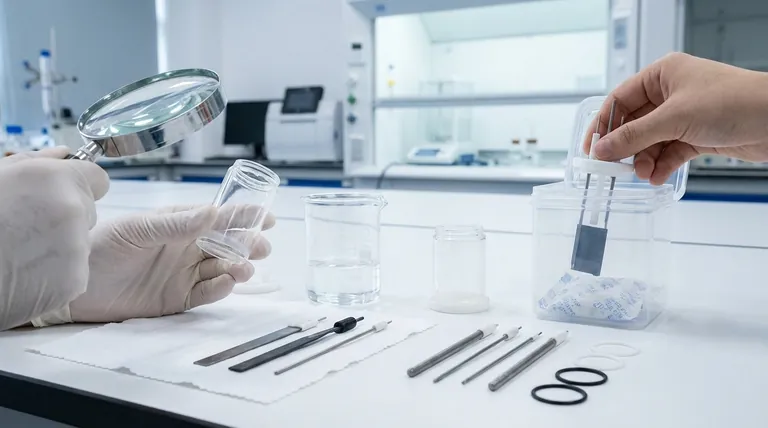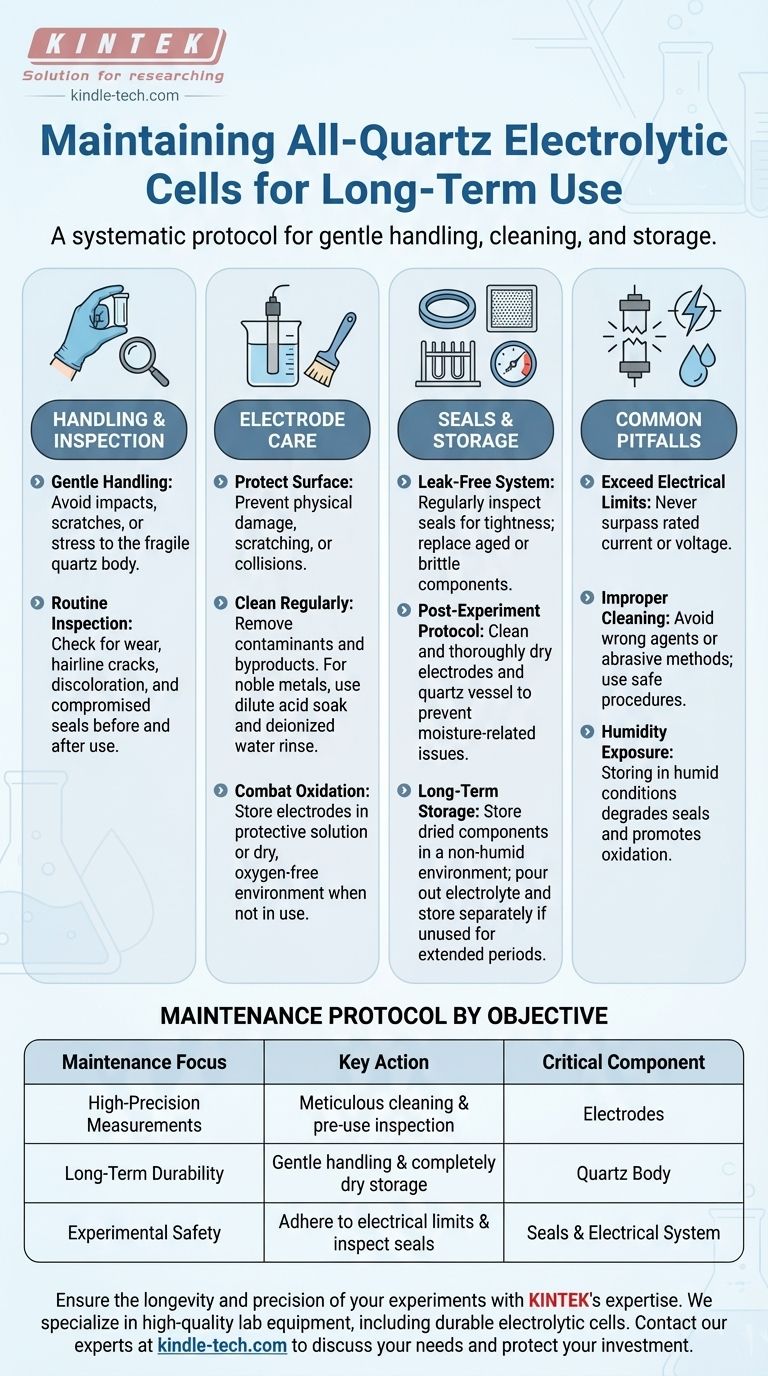To properly maintain an all-quartz electrolytic cell, you must adopt a systematic protocol focused on gentle handling, routine inspection, meticulous cleaning of electrodes, and correct dry storage. The core principle is to treat the quartz body and the electrodes as separate but interconnected components, each with specific vulnerabilities to physical damage and chemical contamination.
The long-term reliability of an all-quartz cell does not come from a single cleaning method, but from a consistent discipline of preventative care. Your goal is to mitigate the two primary risks: physical damage to the fragile quartz and chemical degradation of the highly sensitive electrode surfaces, which are essential for reproducible results.

The Foundation: Handling and Inspection
Your maintenance strategy begins with how you physically interact with the cell. Preventing damage is always more effective than addressing it after the fact.
The Principle of Gentle Handling
The cell body is made of quartz or glass, making it inherently fragile. Always handle the cell carefully to prevent impacts, scratches, or stress that could lead to breakage.
The Habit of Routine Inspection
Before and after each use, conduct a thorough visual inspection. Look for any signs of wear, hairline cracks in the quartz, or discoloration. Check seals for signs of aging or damage that could compromise the system.
Critical Component Care: The Electrodes
The electrodes are the heart of your electrochemical system. Their surface condition directly impacts the quality and accuracy of your data.
Protecting the Electrode Surface
Physical integrity is paramount. Avoid any collisions, scratching, or scraping of the electrode surfaces. Even minor physical damage can alter the electrode's electrochemical properties.
Preventing Chemical Contamination
Regularly clean the electrodes to remove surface dirt and reaction byproducts. For noble metal electrodes like platinum, a common and effective method is to soak them in a dilute acid (e.g., 1M nitric acid) and then rinse them completely with deionized water.
Combating Oxidation During Downtime
Many metal electrodes are prone to oxidation when exposed to air. When not in use, store them in a protective solution or a dedicated dry, oxygen-free environment to preserve the active surface.
Ensuring System Integrity: Seals and Storage
Proper procedure after an experiment is complete is crucial for the cell's longevity.
Maintaining a Leak-Free System
The seals are a critical failure point. Regularly inspect them to ensure a tight fit and prevent leaks. Promptly replace any sealing components that appear aged, brittle, or damaged.
The Post-Experiment Protocol
After use, the electrodes and the quartz reaction vessel must be cleaned and then dried thoroughly. Any residual moisture can lead to contamination or degradation during storage.
Guidelines for Long-Term Storage
Always store the dried cell and its components in a non-humid environment. If the cell will not be used for an extended period, it is essential to pour out the electrolyte and store it separately in a sealed container.
Common Pitfalls to Avoid
Mistakes in operation or maintenance can be costly, leading to damaged equipment or compromised experiments.
Exceeding Electrical Limits
Never exceed the rated current and voltage specified for the electrolytic cell. Overloading the system can cause irreversible damage to the electrodes and compromise safety.
The Risk of Improper Cleaning
Using the wrong cleaning agent or an abrasive method can permanently damage an electrode's surface. Always use a procedure known to be safe for your specific electrode material.
The Consequence of Humidity
Storing the cell in a humid environment is a common mistake. Moisture can degrade sealing components, promote electrode oxidation, and introduce contaminants that will affect future experiments.
A Maintenance Protocol for Your Objective
Your specific focus will determine which maintenance aspects are most critical.
- If your primary focus is high-precision measurements: Your priority is meticulous electrode cleaning and pre-use inspection to eliminate any surface contamination that could skew results.
- If your primary focus is long-term durability: Emphasize gentle handling of the quartz body and ensuring completely dry storage to prevent physical damage and slow material degradation.
- If your primary focus is experimental safety: Adhere strictly to rated voltage and current limits and perform regular, thorough inspections of all seals to prevent system failure or leaks.
A disciplined maintenance routine protects not only your equipment but also the integrity of your work.
Summary Table:
| Maintenance Focus | Key Action | Critical Component |
|---|---|---|
| High-Precision Measurements | Meticulous electrode cleaning & pre-use inspection | Electrodes |
| Long-Term Durability | Gentle handling & completely dry storage | Quartz Body |
| Experimental Safety | Adhere to electrical limits & inspect seals | Seals & Electrical System |
Ensure the longevity and precision of your experiments with KINTEK's expertise. Proper maintenance is key, but starting with the right equipment is just as crucial. KINTEK specializes in high-quality lab equipment and consumables, including durable electrolytic cells designed for reliable performance. Our team can help you select the ideal system for your specific application and provide ongoing support to maximize its lifespan.
Let us help you protect your investment and your research. Contact our experts today to discuss your laboratory needs and discover how our solutions can enhance your workflow's efficiency and accuracy.
Visual Guide

Related Products
- Quartz Electrolytic Electrochemical Cell for Electrochemical Experiments
- Electrolytic Electrochemical Cell with Five-Port
- Electrolytic Electrochemical Cell for Coating Evaluation
- H-Type Double-Layer Optical Electrolytic Electrochemical Cell with Water Bath
- H Type Electrolytic Cell Triple Electrochemical Cell
People Also Ask
- What are the key features of quartz that make it suitable for electrolytic cells? Discover the 4 Pillars of Superior Performance
- What are the available volumes and dimensions for the all-quartz electrolytic cell? Find the Perfect Fit for Your Lab
- What are the necessary steps to prepare an all-quartz electrolytic cell before an experiment? Ensure Accuracy and Safety
- What is the proper procedure for post-experiment cleanup and storage of an all-quartz electrolytic cell? Ensure Longevity and Reproducibility
- What precautions should be taken when handling and using an all-quartz electrolytic cell? Ensure Safe, Accurate, and Durable Performance



















